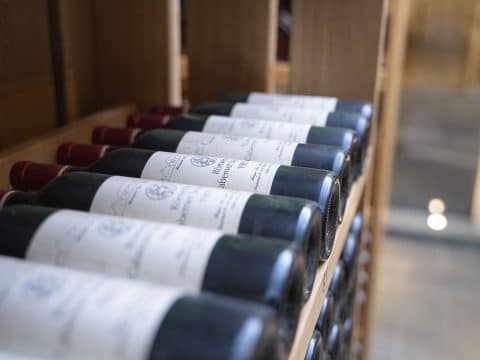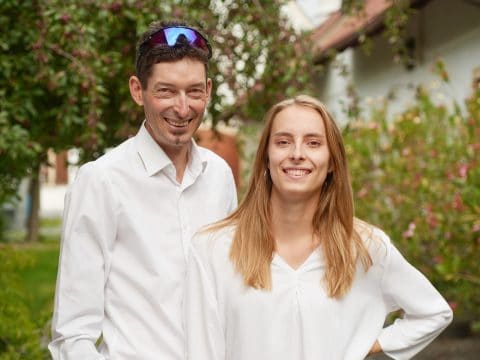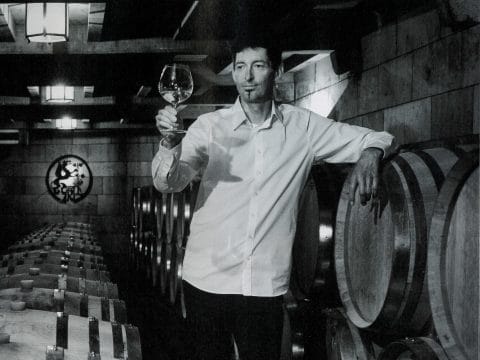Great Wines of Austria, Helmut Romé 1979
Press
The name of the Römerhof wine estate recalls the age when the Roman Empire extended its rule to include this part of the world. At that time the road from Ödenburg to Vienna led through what is now known as Grosshöflein, where the Romans had established a kind of posting house.
The name of this place is first mentioned in 1324, at that time known as Hublen. In the year 1416, an official record referred to it under the name Grossen Hofflein. Since the Counts of Heuflen once resided here, it could very well be that the ultimate name of the municipality was also influenced by theirs. Additionally, the Esterházy princes made their abode in Grosshöflein before building their palace in Eisenstadt. With this the community, which was elevated to the status of a market town in 1701, demonstrates important historical connexions to the development of greater Burgenland. Evidence exists here as well to substantiate a longstanding tradition of viticulture.
The Römerhof estate has been in possession of the Kollwentz family since 1775, and is today devoted solely to the production of wine. The high quality of the estate’s wines shows a mirror image of the attitudes and beliefs of the proprietor—Anton Kollwentz possesses a deep and intimate relationship to wine, a relationship which reaches far beyond any commercial concerns, regarding wine as an essential cultural element of the land and its people. And also here at the Römerhof it is markedly clear: the fashioning hand of the expert craftsman is the most important prerequisite for the production of great wines. The palette of flavours and wines in the house of Kollwentz is very broad, reaching from simple dry table wines up to the highest and most noble Prädikate.
It is noteworthy that the creation of a light and fruity wine is equally typical of Burgenland as are the nobly sweet Prädikatsweine. Unfortunately, many in Burgenland also believe that simple wine can be manipulated into greatness by means of high alcohol content and residual sugar. Anton Kollwentz must certainly be commended as well for the efforts he has made toward the general improvement of red wine in Austria. The Blaufränkisch from the estate demonstrate that there exists in Burgenland those precise climatic and geologic conditions which are essential to the production of good and characterful red wine—that is, if one is prepared to treat red wine as more than merely an afterthought and complement to the whites, and not just as something to be knocked back in the local tavern—and this is to say nothing about the often horrifyingly inadequate state of knowledge regarding the production of red wine which still prevails.
The Kollwentz Estate cultivates 15 hectares of vineyard; 5 additional hectares have been ploughed under in recent years, and will shortly be replanted. There are 2 hectares of Blaufränkisch under vines, which stands at the forefront of the grape varieties. Kollwentz’s Blaufränkisch grows in the vineyard ‘Steinzeiler,’ a south-facing slope on the elongated ridgeline of the Leithagebirge, which contains subsoils of primordial rock covered with fossil limestone. Next comes 1.8 hectares of Welschriesling, which grows in Eisenstadt in the Ried Steinmühle, in gravelly soils interspersed with loam. 1.5 hectares apiece are devoted to Müller-Thurgau (in the Fölligberg in Grosshöflein), and Neuburger (in the Ried Haussatz, a southerly facing site in the Leithagebirge). One hectare of the Fölligberg is planted with Grüner Veltliner, while half a hectare apiece are planted with Sauvignon Blanc (Muscat-Sylvaner in those days), St Laurent and Zweigelt. Smaller parcels are planted to Riesling, Scheurebe, Muskat Ottonel and Traminer. Yields from the entire harvest average under 50 hectolitres per hectare, and in the case of the Prädikat-wines they go as low as 10hl/ha, while the Müller-Thurgau and the Grüner Veltliner reach yields of 80hl/ha.
During the process of vinification in the cellar, white wines spend from 6-8 hours on the skins, after which the must is clarified via racking. Fermentation of the red wines takes place in rotofermenters (in closed containers, on the skins), after which the development of the wines continues in wooden casks. White wines are drawn off very early in order to maintain acidity, while the reds go through malolactic fermentation in cask. The white wines are racked again in January and pre-filtered with sheet filters. Bottling takes place quite early, at latest by the beginning of May, so that the wines retain their fresh-fruit character and carbon dioxide. Red wines are normally not bottled before September. The white wines have a fresh and fruity nature, very pure in aroma, nicely rounded with a piquant and fruit-driven acidity. The Prädikat-wines often attain extremely finesseful heights of expression, while red wines are impressively rich in tannin and body, showing a well-balanced flavour and a fine bouquet. The acidity—which is never reduced at Kollwentz—imparts character to the wine, along with excellent potential for cellaring.


